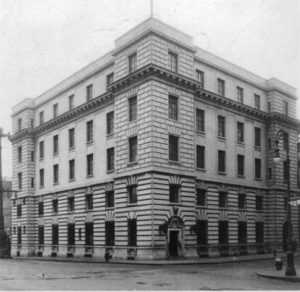
Constructed in 1909, the large, block-long police station at 118 Clinton Street was quite the fortress, but it was simply not big enough to peacefully accommodate Buster and Topsy, the rival police cat mascots.
In December 1911, the policemen of the old Eldridge Street police station in New York City’s Lower East Side moved into the new station house constructed for the men of the old Delancey Street station. Although the new station at the corner of Clinton and Delancey streets was more than big enough to accommodate everyone, the rival police cats, Buster and Topsy, refused to share the same territory.
In Part I of this old New York City Police mascot story, we learn that the move to 118 Clinton Street was a disaster for the little male cat, Buster, who was clearly bullied by the much larger female cat, Topsy. One has to wonder if the outcome would have been different had the two feline mascots been of the canine persuasion instead.
Part II: Yaller, the “Fire Dog” of the Eldridge Street Police Station
About 12 years before the two police precincts merged, the old Thirteenth Ward (Delancey Street station) had a canine mascot named Tom and the old Tenth Ward (Eldridge Street station) had a canine mascot named Yaller (the Eldridge Street men also had another cat mascot named Peter as well as a mascot eagle during this time). Both Tom and Yaller were mongrel dogs who loved responding to fires and backing up their human partners during burglaries, street fights, and other crimes.
Sadly, Tom, who joined the Delancey Street station in 1896, was run over by a horse car on Madison Street on May 22, 1899. Yaller, who joined the Eldridge Street station in 1890, had a much longer and more celebrated career filled with numerous valiant acts.
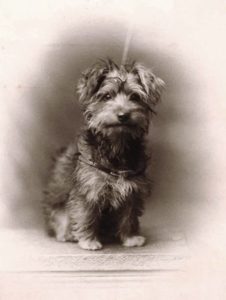
This is not Yaller: according to Doorman Frank Goodrich, “Yaller won’t have his picture taken. He despises a camera, and it would take a regiment to hold him in position for a snapshot.”
It’s not really clear how Yaller, described as “a very small, meek-looking dog of a nondescript color,” ended up at the Eldridge Street police station, although much was written about him in the New York City newspapers.
According to a December 16, 1900, article in The New York Times, Yaller was originally an unwelcome guest at the station house. As this story goes, Yaller spent much of his time at a small grocery store just opposite the station house. When the owner retired and moved back to Italy, Yaller invaded the station house for food and shelter.
For the most part, Yaller was not treated kindly; however, one of the sergeants was nice to him and allowed him to stay inside from time to time.
On January 12, 1902, the Times reported that Patrolman Jack Gallagher and Doorman Frank Goodrich came to Yaller’s rescue one day when a man ran into the station yelling about a dog that had gone mad at a nearby saloon. When the two policemen arrived, they were just about to shoot the dog when they noticed a tin can tied to his tail. The men removed the can and calmed the dog by petting him. From that moment on Yaller was a member of the New York Police Department.
However he came to be attached to the Eldridge Street station (I prefer the second story), Yaller certainly earned his keep by catching crooks and saving lives. One of his very first acts of bravery was tackling a man who had stolen a purse from a woman. Over the years he caught many thieves by chasing them down, biting at their trousers, and barking as loud as he could until his human partners arrived on the scene. He also came to the rescue of many people, including civilians as well as his fellow officers.
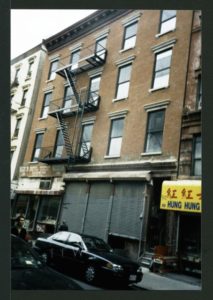
The old Eldridge Street station house, where Yaller lived most of his life, was located in this four-story, 1867 building at 105-107 Eldridge Street. This photograph was taken in 1999; today the commercial space — most recently a bar called Fontana’s — is vacant. (New York Public Library digital collections)
Yaller was also a great fire dog who could “smell a fire quicker than any dog that ever breathed.” Whenever he smelled smoke, he’d run up to the building and start barking to alert the tenants. He was never afraid to run into a burning building with the firemen and policemen. Once inside, he’d jump against doors, wake people up, and then chase them down the stairs to safety.
In 1897, Yaller helped save dozens of people who were living in a crowded six-story tenement at 26 Allen Street. According to the story, everyone in the house was asleep when Samuel Berkowitz returned home from work to find the building on fire. His cries alerted policemen Stiller, Cohen, Cunningham, and Yaller.
The three police officers ran into the building and began rousing the tenements out of bed. Yaller ran up to the fifth floor, barking loudly and pawing at every door along the way. When they thought all of the people had escaped, the policemen called for Yaller, but he refused to come.
Cohen ran back up the stairs, where he found Yaller pawing at a door on the fifth floor. Sure enough, the family had not been awakened.
After the family was led to safety, Yaller led Cunningham to the third floor, where Mrs. Nathan Tusk and her baby had become overcome by smoke and terror. Mother, baby, man, and dog all made it out safely.

This photograph, titled “Typical tenement fire escape” was taken on Allen Street by Jacob A. Riis in 1890. Yaller saved many lives by alerting the tenement residents whenever there was a fire. (Museum of the City of New York collections)
In reward for his hard work, the policemen often fed Yaller sponge cake, which was favorite food of all. Yaller also loved all men in police uniforms — he didn’t take very well to plain-clothed inspectors or captains — and he especially loved partnering with those men whose posts were in front of restaurants.
Yaller also got along very well with the station’s other mascots, including a mascot eagle who arrived in 1894 and a mascot cat named Peter, who had a knack for stealing steak dinners from the sergeants.
A History of the Eldridge Street
Police Station
The station house at #105-107 Eldridge Street (originally #87-89), where Yaller spent most of his life, was located on a 50 x 100 foot lot that the city purchased on July 3, 1867, from Herman F. Bauer and his wife Bertha for 24,500. The station house, which also included a two-story prison, was designed by renowned police department architect Nathaniel D. Bush.
The Eldridge Street police station was one of several stations that contained a woman’s shelter, led by
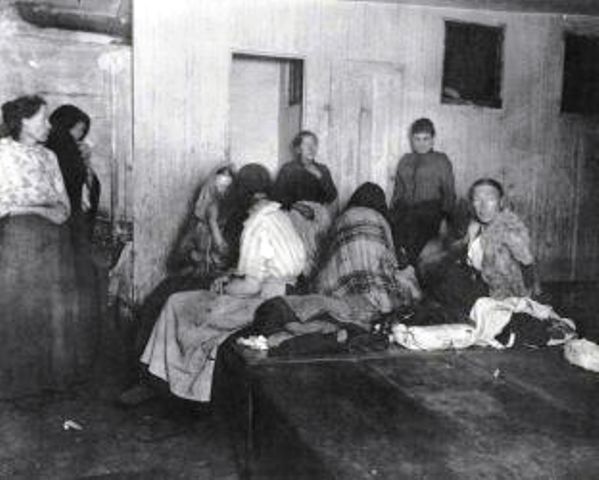
The Eldridge Street police station was one of several stations in New York City that contained a women’s shelter. Matron McCarthy ran this shelter for destitute women from 1892 until about 1908. Photo by Jacob A. Riis, 1890
Prior to moving into Eldridge Street in 1868, the policemen of the old Tenth Ward were originally housed in the old Essex Market, which dates back to 1818.
The Essex Market
In 1818, the Board of Alderman voted to build a marketplace, 40 x 20 feet, at the center of Grand Street between Ludlow and Essex streets. The market — one of 13 such market places constructed in the early 19th century — was named after Essex Street, which was laid out in 1765 along the east side of the Great Square (Delancey’s Square), located near the center of James Delancey’s farm.
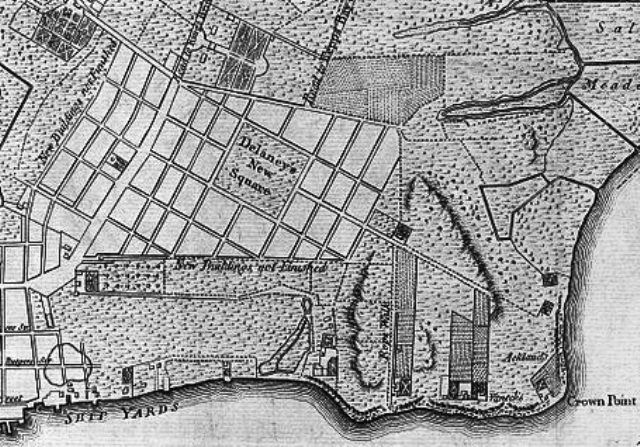
The Essex Market (and Eldridge Street police station) was constructed on Delancey’s Square (1760s). The grand square was bounded by present-day Eldridge, Essex, Hester, and Broome streets. The loyalist Delanceys lost all their land after they were exiled following the Revolutionary War, and the state’s Commissioners of Forfeiture eliminated the square.
In 1823, the city purchased seven more lots north of Grand Street owned by Nicolas Governeur, and erected a one-story building on this site. At this time, there were 14 butcher stands in the center of the building, with fish and vegetable stands on the ends.
In October 1836, the old market house was ordered taken down; the materials were used to build the Tompkins Market. The old market was replaced by a much larger one-story market and two-story building butting against Broome Street. This building was used for market purposes as well as for apartments for the Second District Watch (the old police system), apartments for the clerk of the market, and a room for public use.
In 1844, when the Board of Alderman abolished the Watch system and replaced it with and Day and Night Police, the Tenth Ward (also called the J District) moved into the second floor of the market, with an entrance on Ludlow Street.
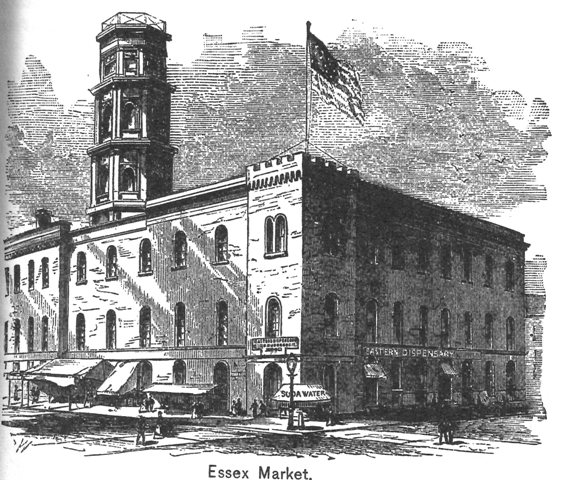
In the spring of 1852, the city replaced the old market with a large brick building at the cost of $50,000. The second and third floor were occupied by the Tenth Ward station house, police court, justice court, Superintendent of Streets and Lamps, and drill rooms for the military. On the market floor was the Eastern Dispensary (medical care for indigents), plus 24 butcher, 20 vegetable and poultry, 8 butter and cheese, 6 fish, 2 smoked meats, 2 coffee and cakes, and 1 tripe stand. The tower was probably used as a fire watch tower.
In 1857, the policemen of the old Tenth Ward moved into the new Essex Market Police Court, a large, modern building constructed at the intersection of Essex Street and the old Essex Market Place. Ten years later, the 71 policemen of the Tenth Precinct moved into their new Eldridge Street station house.
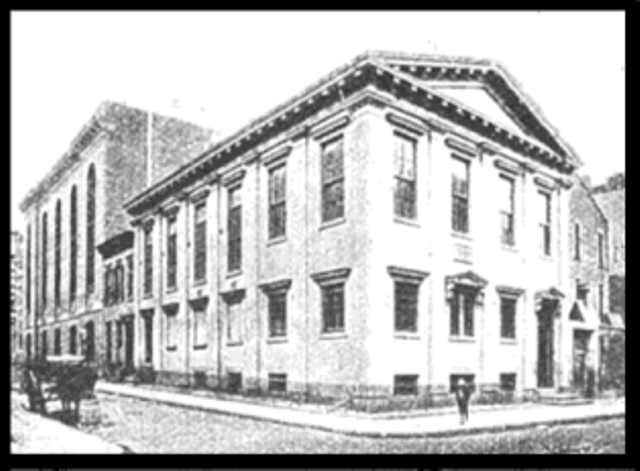
The Essex Market Police Court and prison was at the intersection of Essex Street and the old Essex Market Place (pictured at left), a narrow cross street that ran between Essex and Ludlow streets until 1926. In 1895 the building housed a market and school on the first floor, a school and meeting rooms on the second floor, and the Volunteer Firemen’s Association on the third floor. In the cellar were basket stores, book stores, furniture store, and other shops.
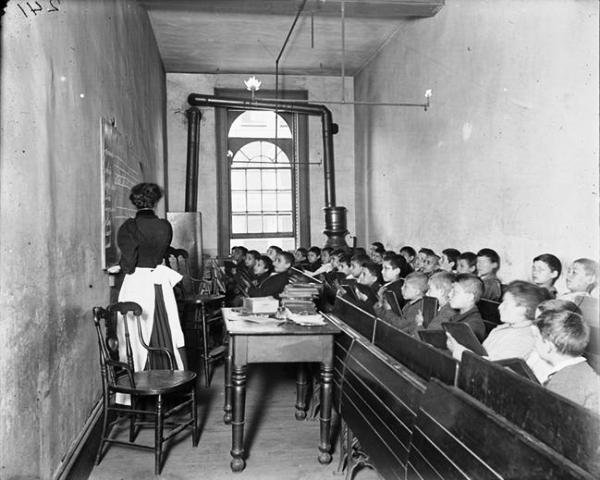
In 1895 a resolution was passed which closed the old Essex Market and allowed the Board of Education to take over the building as a school – despite the fact that it had poor ventilation and sanitary facilities. Photo by Jacob A Riis.
In 1912, the city leased the old Eldridge Street police station to Moritz Tolk, a saloon owner. The following year, noted architect Louis A. Sheinart converted the upper floors into lofts. The building has had a fascinating history in its 150 years, but probably none as exciting as when Yaller, Peter, and Topsy made the police station their home.
ssssss



